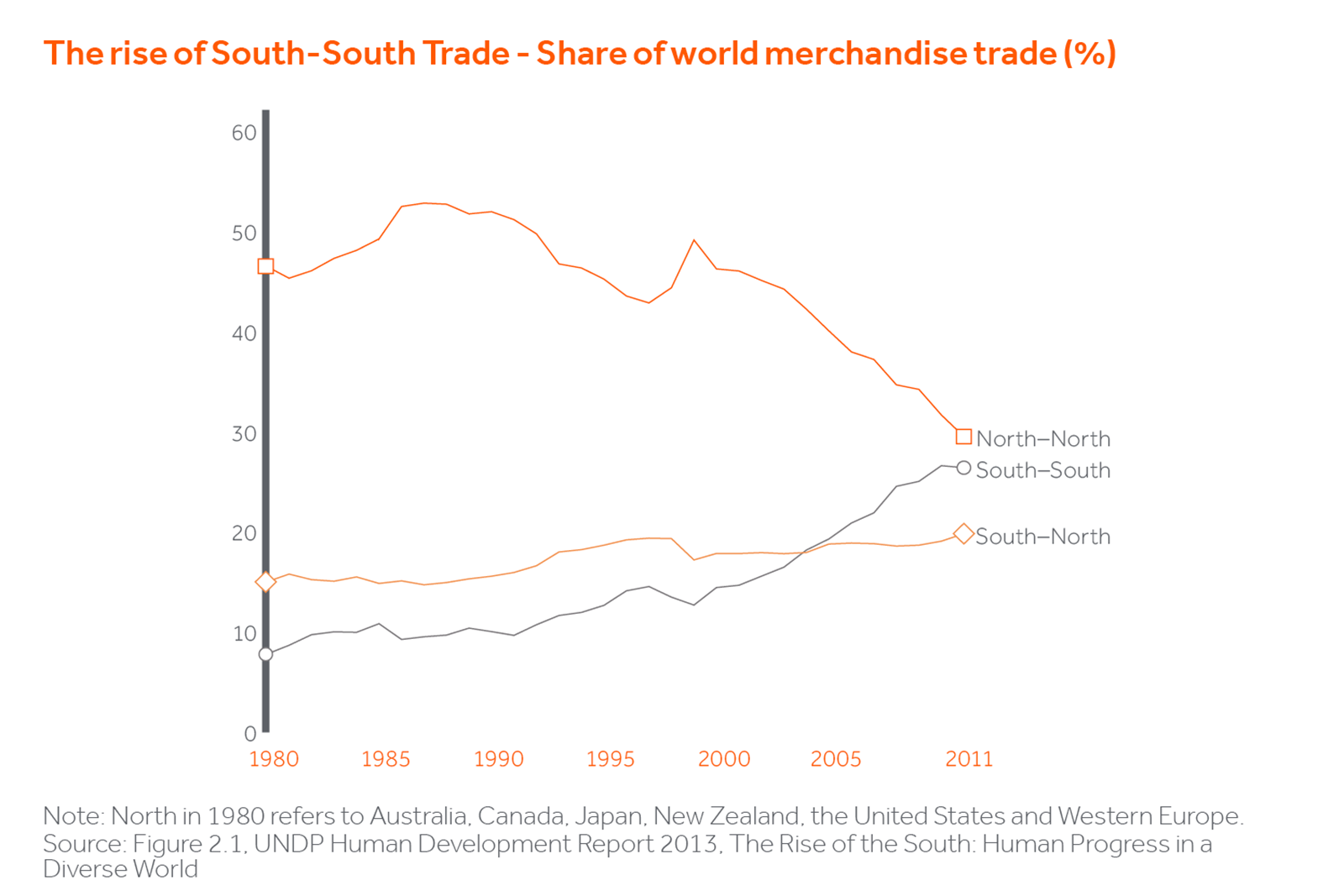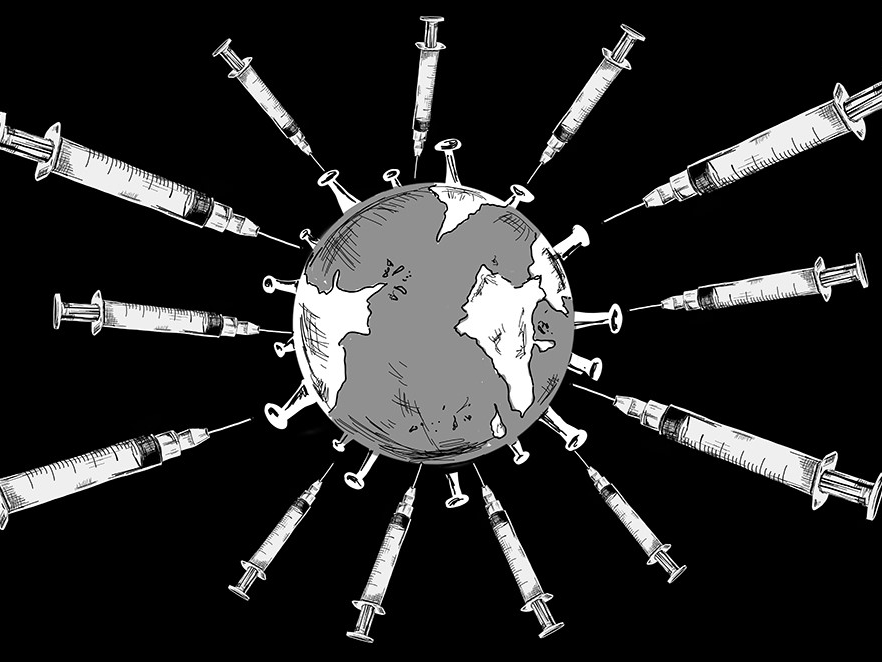Back in 2004, the UN stated that a “new geography of trade is emerging and reshaping the global economic landscape’’. What they noticed was the formation of the growth markets of the southern hemisphere into an economic entity in their own right, a phenomenon they called South-South to rival the more traditional North-North and North-South developed country trading relationships. Defined by increasing levels of investment and trade with each other, the UN had rightly observed a growth phenomenon in the south that would ultimately change how we view the existing world order.
Fast forward to today and we have seen fundamental and increasingly important shifts in the global socio and macro-economic environment. With the numerous challenges the North has had to face, we can now see increasing and tangible indicators of how the South has gained macro share, driven particularly by the extraordinary growth stories of China and India.
Growth markets accounted for a half of the world’s merchandise exports in 2014, growing from one third in 2000. China tripled its share of world exports between 2000 and 2012. South-South trade – the exports and imports of goods and services between growth markets in the southern hemisphere – has risen from an 8.1% share of world trade in 1980 to 26.7% in 2011. Forecasts suggest that this could increase to over 40% in the next 20 years.

This is important. As North-North trade continues to decline from 46% of world exports to now around 30%, the southern growth market power block is becoming much more important as a driver of global trade and development. Through the demonstration of “soft power’’, growth markets are gaining strength through mutual assistance and support through aid, development funding, trade, investment and infrastructure. By sharing information and technological innovations to bridge the knowledge gaps between developing countries, growth markets are converting these insights to drive an increasing rate of industrialization in the countries that are least developed.
The agent of change
China’s commitment to investment across Asia, Africa and Latin America is the big driver of change in the south. Through redirecting its domestic over-capacity and capital to southern neighbors in the form of increasing external infrastructure investment, China is attempting to ensure its own future economic security by making itself the long term beneficiary of increasing trade flows and reciprocal economic benefits with countries it is investing in, most visible in the supply of natural resources back to China.
In September 2016, we saw a further strengthening of China’s role in global trade when it was announced that the Chinese Yuan would be included in the basket of currencies of the IMFs Special Drawing Rights, meaning that central banks around the world can elect to hold in reserve the Yuan and thereby future trade agreements wherever they might be in the world can be agreed and conducted in Yuan. It is expected that this will reduce the importance of the US dollar in these markets and facilitate an ever greater role for China.
In a classic case of history repeating itself, in 2013 China announced the creation of the Silk Road economic belt and the Maritime Silk Road to improve the connectivity between China and the land masses of Asia, Eastern Africa and Europe, anticipating cumulative investment in the next decade of up to $1trillion. Also called “One Belt, One Road’’, the parallels with ancient silk routes that began during the Han dynasty (207 BCE to 220 BCE) are striking.
Africa is perhaps the most significant beneficiary of China’s “South-South” investment. Over the period from 1992 to 2011, trade between China and Sub-Saharan Africa rose from $1bn to a staggering $140bn. China is clearly looking to capitalize on the fact that with 15% of the world’s population, Africa only accounts for 3% of global trade. China now takes more African exports than the USA.
As recently as October 2016, we saw the launch of the fully electrified Ethiopia-Djibouti railway, linking Addis Ababa with the port of Djibouti on the Red Sea, fully funded by Chinese banks and built by Chinese companies, an example of how China is using infrastructure investment to open up the continent to intra-African trade. And this isn’t the first example, following on from previous openings of modern railway lines in Angola and Nigeria as well as the ongoing construction of the Mombassa-Nigeria railway in Kenya.
Over 2000 Chinese companies have invested in, or are looking to invest in Africa. Nearly all investment goes into energy, mining, construction, manufacturing and services. China is Africa’s biggest lender for infrastructure financing. The Export-Import Bank of China has signed up to major projects with the African Export-Import Bank and with the government of Tanzania. The plan is to construct industrial parks and economic zones for light industry and processing of raw material and commodities worth up to $1bn. In another example, Chinese companies have become the biggest builders of hydropower dams in Africa and have broadened this recently to the construction of water treatment stations and water supply projects. Yet it’s not all big infrastructure investment. Small and medium sized Chinese investment is growing in the form of business services, be it in restaurants, hotels or small manufacturing/export companies.
Of course, these examples of south-south cooperation have to be a win-win for both sides. South Africa – China’s largest trading partner in Africa – is benefiting from increased investment in manufacturing and in newer industries such as e-commerce. In October 2016, Eskom, the South African electricity utility and the China Development Bank signed a $500m credit facility agreement that will allow Eskom to complete its planned capital expansion projects. China, in return, is also benefiting by opening its markets to investment from a number of South African companies such as Sasol, De Beers, Naspers MIH, SAB Miller and First Rand.
New Kid on the (African) Block
Growth in India has created the demand for new markets and resources. Focus has zeroed in on Africa and trade between India and Africa has increased from $5bn in 2005 to a likely $100bn this year. We are now seeing India as an increasingly important player in African investment, particularly in pursuit of energy security. India continues to search for new suppliers away from the more volatile western Asian oil suppliers. India has been investing in Nigeria, Sudan, Cote d’Ivoire and Ghana to name but a few. The current 20% of oil imports India receives from Africa is most likely to continue growing.
In July 2016, Prime Minister Modi made his first tour to Africa, signing agreements with Mozambique, Tanzania, South Africa and Kenya, all East African Indian Ocean facing countries and strategically positioned to counter China’s growing presence in these areas. 19 agreements were signed, including deals in information technology, water resource management, food security and healthcare along with the usual natural resource projects.
In the same way that China is fostering long term relationships and benefits through infrastructure construction. India is doing the same thing but focusing also on education, vocational training and skills development in Africa. The model is a “pro-people’’ model, providing the necessary personal skills necessary in order to deliver the anticipated benefits of a long term trading and economic relationship between the two regions.
South-South and Actis
At Actis, South-South isn’t primarily about trade, although we are starting to see how China-Africa investment is affecting some of our portfolio companies in South Africa. Actom, the largest manufacturer and distributor of electro-mechanical equipment in Africa is increasingly looking to source technology out of China, including pre-paid meter technology. The reciprocal benefit for Chinese companies is access to the fast-growing African electricity market through the Actom platform. Coricraft, a South African manufacturer and retailer of high quality furniture and homeware, imports c.50% of its product range and materials from the East, of which 20% is sourced from China, and c.20% from Indonesia.
Instead, South-South is about using our global presence and investment experience in the southern hemisphere to focus on the transfer of knowledge and expertise between our portfolio companies as complementary trading patterns continue to emerge. Such exchanges help us build connectivity between our investments and facilitate their market entry and procurement strategies to take advantage of these trends. An example is the joint sourcing by our energy platforms of Chinese manufactured solar panels to ensure we are as cost competitive as we can be.
We closely watch South-South co-operation through trade and investment. We recognize the ongoing global shift in trading and investment patterns and also understand that this is not just a China-India-Africa story. We could talk about the reciprocal relationships between Latin America and Eastern Asia just as easily. A “new geography of trade” has indeed emerged.






